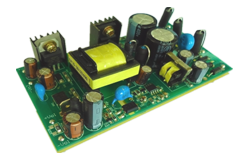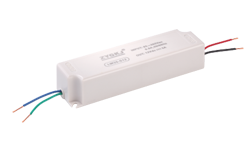nouvelles
Understanding AC-DC Power Supply: A Comprehensive Guide
Auteur: Module d'alimentation ZYG Time: 2023-5-2
An AC-DC power supply is a device that converts AC voltage into DC voltage. This type of power supply is essential for many electronic devices that require a stable and reliable source of DC power.
In this guide, we will take a comprehensive look at AC-DC power supplies, including their types, specifications, applications, and common issues.
Types of AC-DC Power Supplies
There are several types of AC-DC power supplies, each with its own unique characteristics and applications:
1. Linear Regulated Power Supplies: These power supplies use a linear regulator to reduce AC voltage to a stable DC voltage. They are simple, reliable, and inexpensive but generate a lot of heat and are not efficient.
2. Switching Power Supplies: These power supplies use a switching regulator to convert AC voltage to DC voltage. They are highly efficient, generate less heat, and are compact. However, they are more complex and expensive than linear regulated power supplies.
3. Unregulated Power Supplies: These power supplies do not use a voltage regulator and provide a fixed output voltage regardless of the input voltage. They are simple and inexpensive but provide a less stable output voltage.
4. Variable Power Supplies: These power supplies allow you to adjust the output voltage according to your needs. They can be linear regulated or switching regulated and are ideal for testing and prototyping.
Specifications of AC-DC Power Supplies
When choosing an AC-DC power supply, it\’s essential to consider its specifications to ensure it meets the requirements of your device. Here are some critical specifications to consider:
1. Output Voltage: This is the DC voltage that the power supply provides. It should match the voltage requirements of your device.
2. Output Current: This is the maximum current that the power supply can provide. It should be higher than the current requirements of your device.
3. Ripple and Noise: This is the amount of AC voltage present in the DC output. It should be as low as possible to prevent interference with your device.
4. Efficiency: This is the percentage of input power that is converted into output power. It should be high to reduce energy consumption and heat generation.

Applications of AC-DC Power Supplies
AC-DC power supplies are used in a wide range of electronic devices, including:
1. Computers and servers
2. Audio and video equipment
3. Medical equipment
4. Telecommunications equipment
5. Industrial automation systems
Common Issues with AC-DC Power Supplies
Even the most reliable AC-DC power supplies can experience issues, including:
1. Overheating: This can occur when the power supply is not adequately ventilated or is overloaded.
2. Output Voltage Drift: This can occur when the power supply is subjected to temperature changes or load changes.
3. Ripple and Noise: This can occur when the power supply is not adequately designed or has faulty components.
4. Short Circuit: This can occur when the output voltage of the power supply is shorted to ground.
In conclusion, an AC-DC power supply is a critical component in many electronic devices, and it\’s essential to choose the right type and specifications. By understanding the types, specifications, applications, and common issues of AC-DC power supplies, you can ensure that your electronic devices have a stable and reliable source of DC power.
Précédent: Designing an AC-DC Converter Circuit
Prochain: Industrial AC-DC Converter for Efficient Power Conversion
les informations pertinentes
-
2023-4-23
Distinguishing Between AC and DC Power Supplies
AC and DC power supplies are two types of electrical power sources commonly used in various applications. AC stands for alternating current, while DC stands for direct current. The main difference between the two is the direction of the flow of electrons through the circuit. In this article, we will discuss the differences between AC and DC power supplies in terms of their characteristics, applications, and advantages. Characteristics of AC Power Supplies: AC power supplies provide electrical power that changes direction periodically. The voltage and current in an AC circuit oscillate sinusoidally, which means that they change direction and magnitude constantly. The frequency of this oscillation is measured in Hertz (Hz) and is typically 50 or 60 Hz in most...
Voir les détails -
2023-5-12
24V AC to DC Converter manufacture: Efficiently Converting Alternating Current to Direct Current
Introduction In an electrical circuit, alternating current (AC) is the form of electricity that flows back and forth through the circuit. However, many electronic devices require direct current (DC) to operate. This is where an AC to DC converter comes into play. In this article, we will discuss the 24V AC to DC converter and how it efficiently converts AC to DC. What is an AC to DC Converter? An AC to DC converter is an electrical device that converts AC power to DC power. This device is commonly used in electronic devices such as computers, televisions, and mobile devices that require DC power to operate. The AC to DC converter works by rectifying the AC power and converting it...
Voir les détails -
2023-4-12
Creating an AC-DC Converter: A Guide to Converting Alternating Current to Direct Current
If you work with electronics, you may find yourself needing to convert AC (alternating current) to DC (direct current) at some point. This can be done with a simple AC-DC converter circuit. In this guide, we walk you through the process of creating your own converter circuit. First things first, let\ explain the difference between AC and DC. Alternating current is the kind of electricity that comes out of your wall socket. It oscillates back and forth, changing direction 50 or 60 times per second. Direct current, on the other hand, flows in one direction only. Most electronic devices require DC to function. To create an AC-DC converter, you need a few basic components. These include a transformer, a diode...
Voir les détails -
2023-12-4
In today's rapidly evolving technological landscape, the need for reliable and efficient power supply modules is paramount. Whether it is powering electronic devices, charging batteries, or providing stable voltage outputs for various applications, having a versatile and adjustable power supply module is essential. One such solution that has gained popularity in recent years is the DC to DC step-down adjustable power supply module. This module not only offers efficient voltage regulation but also allows for customized power outputs based on specific requirements. In this article, we will delve deeper into the functionality and benefits of this innovative power supply module. Functionality: The DC to DC step-down adjustable power supply module serves the purpose of reducing the input voltage to a...
Voir les détails -
2023-5-18
Powering electronic devices with a safe, reliable, and efficient energy source is a constantly-evolving field in the world of technology. One of the best ways to accomplish this task is by utilizing an AC-DC power supply. AC-DC stands for Alternating Current and Direct Current respectively. Alternating Current or AC is used as the type of electricity we can get from power outlets at homes while Direct Current or DC is used for the operation of certain electronic gadgets. Some popular electronics, such as laptops or tablets, boast internal rechargeable batteries that are charged with electricity when it falls below a certain percentage. But, in their functioning, lithium-ion ensures that there is a completely different voltage register produced every now and...
Voir les détails -
2023-8-6
12V AC to DC Converter for LED – Efficiently Powering LED Lights with Smooth Conversion
Introduction: In recent years, LED lights have gained immense popularity due to their energy efficiency and longer lifespan compared to traditional incandescent bulbs. However, LED lights require direct current (DC) power to operate, while most homes and buildings have alternating current (AC) power supply. To bridge this gap, a 12V AC to DC converter for LED lights is used. This article aims to explore the functionality and benefits of such a converter in efficiently powering LED lights with smooth conversion. Understanding the Converter: A 12V AC to DC converter is an electronic device that converts the alternating current from the power supply into direct current suitable for LED lights. The converter consists of various components, including a transformer, rectifier, and...
Voir les détails


















